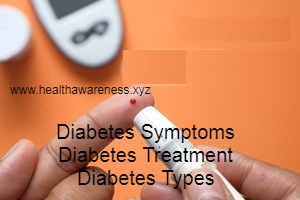Diabetes
Diabetes mellitus is a hormone-related disease. If the body's pancreas cannot make enough insulin or if the body fails to use the insulin it produces, then the disease is called 'diabetes' or 'diabetes'. Then there is the imbalance caused by the presence of sugar in the blood. Insulin deficiency is the main cause of this disease. The hormone insulin, secreted by the pancreas, enables the body's cells to take in glucose from the blood and use it for energy. If there is no one or both of the insulin production or the ability of insulin to work, then blood glucose continues to rise. When left unmanaged, they can be left astray and lose the right path.
Diagnosis of Diabetes
Human blood glucose normally ranges from 3.3 to 6.9 ml / l and after food to <6.8 ml / l. But if glucose contains unhealthy ml.
Type 2 Diabetes
Diabetes is usually referred to as diabetes mellitus. However, there is another disease called diabetes insipidus which causes increased urine production but it is due to lack of production or action of another hormone called ADH antidiuretic hormone. No relationship. The prevalence of diabetes mellitus is much higher between the two. Diabetes mellitus can be of two types. Namely: type-1 or insulin-dependent and type-2 or insulin-neutral diabetes.
Type-1 Diabetes
Type 1 diabetes is an autoimmune disease. In this disease, the insulin-secreting cells of the pancreas are destroyed. Therefore, for those who have type-1, their body produces very little insulin. For this, the patient has to take an insulin injection or an insulin pump to survive. This type of diabetes is more common in children and adolescents. Occurs in 10-30 years. It is mainly due to genetics. Two genes, HLA-DR 3 and HLA-DR 4 are responsible for this.
Type-1 can be further divided into two parts
Type 1 diabetes is caused by the destruction of beta cells for autoimmunity.
Type-1-B is also caused by beta cell destruction, but the exact cause is not known. (1) Increases blood glucose (> 130 mg / 100ml). (2) The amount of body scattered in the blood increases. (3) Glucose is excreted through urine or glucosuria.
Type-2 Diabetes
Type 2 diabetes is caused by insulin resistance. Type 2 patients cannot use the insulin that is produced in the body. This is dealt with first with the help of exercise and diet. However, many times oral medications are needed, even insulin injections. This type of diabetes occurs after 40 years or so. Sweet and sugary drinks increase the risk of type-2. The type of fat in the diet is also important; Eating rice also increases the risk of diabetes. Non-physical activity is also one of the leading causes of type 2 diabetes. More than 90 percent of the 246 million diabetic patients worldwide have type 2 diabetes. Both types of diabetes are serious and can affect children and adolescents. For this, it is very important to know the danger signs of diabetes. There is no such thing as 'mild diabetes'.
Other types
In women, the third type of diabetes occurs during pregnancy. It is also known as gestational diabetes.
Common symptoms (diabetes symptoms)
Frequent urination. This is why the disease is called diabetes;
Excessive thirst and dry mouth;
Extreme weakness;
Constant hunger;
Weight loss in a short time;
Blurred vision;
Frequent infections.
Features and various complexities
Excess fat is one of the causes of the disease;
Lack of treatment due to asymptomatic or unconsciousness;
Diabetes is one of the leading causes of kidney failure;
Diabetes is one of the leading causes of blindness or visual impairment;
Diabetes is one of the leading causes of amputation without accident.
Treatment of diabetes
Insulin
Antidiabetic medicine (oral medicine)
Lifestyle changes: Regular exercise, dietary awareness, patient's perception of the disease.

Post a Comment